-
Engine4.0L Flat-6
-
Power500 HP / 338 LB-FT
-
Transmission7-Speed DCT
-
0-60 Time3.1 Seconds
-
Top Speed193 MPH
-
DrivetrainRear-Wheel Drive
-
Engine PlacementRear
-
Curb Weight3,153 LBS
-
Seating2
-
Cargo4.4 CU-FT
-
MPG14 City / 20 HWY
-
Base Price$175,900
We're trying to suss this out at 120 miles per hour on the long downhill back straight at Road Atlanta. It's pouring. Rivulets of water are streaming across the track. Ahead, in a 911 Turbo leading the pack, is Le Mans- and Daytona-winning driver David Donohue. He's helpfully warned us to avoid nipping the curbing, since that's where water pools. Hydroplaning could end someone's day.
Through the blinding spray, Donohue mercifully has reduced the pace. There's enough speed to evaluate what the GT3 RS does well, which is essentially everything. There's also enough time to figure out what sort of sports car this is.
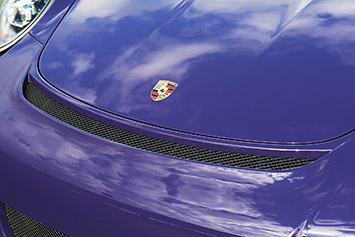
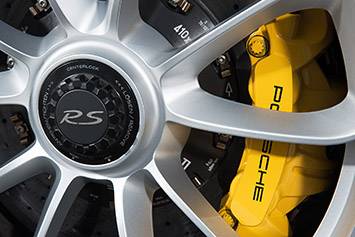
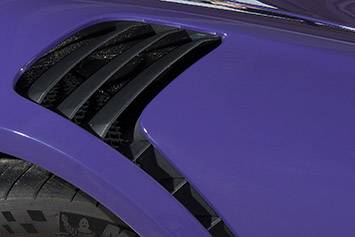
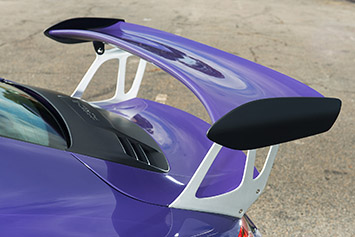
As is fitting and proper for the traditional sports car par excellence, at the top of the large and expensive 911 heap is the GT3. While the base is shaken by the encroachment of turbocharging on basic 911 models, the summit is, like mountain air, all-natural. The GT3 was subject to a beyond-galling recall due to faulty con-rods with a penchant for ventilating crankcases and starting catastrophic fires, but storms crash upon every peak. Progress is inevitable for German engineers. The GT3 RS is the 911 reforged in those embarrassing fires. The GT3 itself was a false summit, but the RS is the real deal.Horsepower swells to an even 500 and torque to 338 pound-feet – bumps of 25 hp and 14 lb-ft over the GT3.
Underneath the very purple bodywork, this is a lither and more athletic thing than the already superb GT3. Lightweighting is accomplished with a healthy dose of carbon fiber on the engine cover and the frunk. The roof, with a slick-looking depressed slash running longitudinally, is made of magnesium. That serves to lower the center of gravity, Porsche assures us. Even the rear silencer is made of titanium. In total, the RS is 22 pounds lighter than the GT3 it's based on – seemingly small gains considering all the exotic materials, but less so considering what's been added back.
The RS is also more powerful, thanks to a 200cc displacement increase. The regular GT3's 3.8-liter six was already bored out to its maximum, so the extra displacement comes from a longer stroke. That serves to lower the redline slightly, from 9,000 rpm to 8,800 (although peak horsepower is the same, at 8,250 rpm), but horsepower swells to an even 500 and torque to 338 pound-feet – bumps of 25 horsepower and 14 pound-feet. This engine is a serious piece of equipment, boasting dry-sump lubrication, direct injection, and lightweight engine internals like titanium connecting rods. It breathes through those side intake scoops that confused everyone when the first spy shots of this vehicle surfaced – instead of feeding big intercoolers like on a 911 Turbo, they cram air into the naturally aspirated RS's intake manifold. Neat stuff.
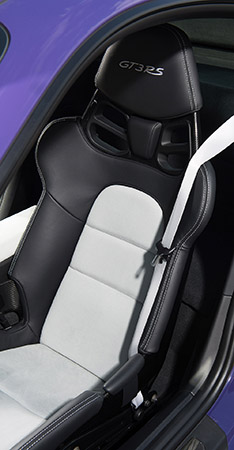
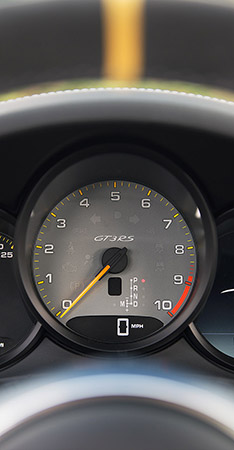
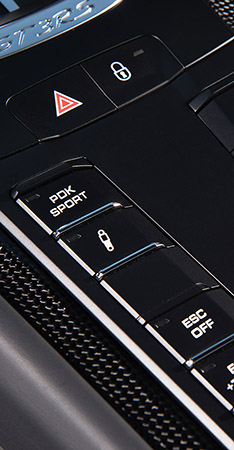
Like the GT3, the RS is available only with Porsche's dual-clutch PDK transmission. The seven available ratios are shorter here, and shifting is blink-and-you'll-miss-it quick. After pulling the paddles a few times, I decided to see how the PDK would shift itself, and, considering the deluge, never bothered to put it back in manual mode. In full-auto, this transmission is smart enough to hold revs properly, shift when it makes sense on a track, and never hunt between gears. Choose your own adventure: yank a paddle or let the car shift for you. There's no real downside.The RS is rock-steady even under ham-fisted mishandling.
But there is downforce. A lot of it. The new front splitter and the slatted fender vents provide 243 pounds at 186 mph, and the coffee-table-sized rear wing contributes 485 pounds. Along with the massive 265-35/20 front and 325-30/21 rear tires and superbly tuned magnetorheological shocks, the RS is rock-steady even under ham-fisted mishandling. And communicative, too. Donohue has wisely advised us to leave the stability control to the computers, and there's enough processing power and gobs of mechanical grip to keep the rear end firmly planted.
Despite all this, the driver isn't totally isolated from the drama. We're mostly running Road Atlanta at speeds too low for downforce to affect the car, so most of the feedback comes from the front wheels gently pushing back against driver error, sending clear and unambiguous messages right to our hands gripping the lovely Alcantara-covered wheel. The RS also has rear-steer, which must contribute to the car's brilliantly sharp turn-in characteristics, but at these speeds and in these conditions it's difficult to determine which masterful subsystem is responsible for which incredible driving characteristic.
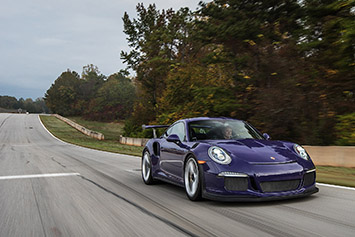
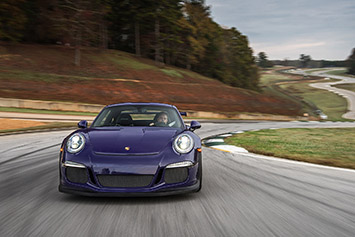
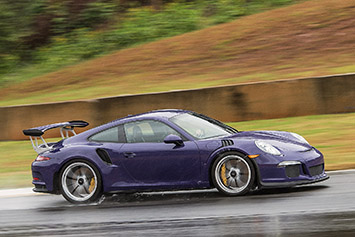
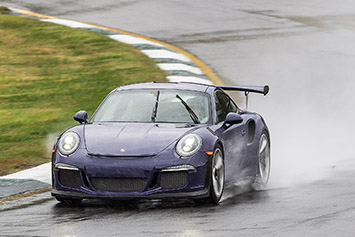
One thing is completely unambiguous: The Michelin Pilot Sport Cup 2 tires are a miracle. We had a flock of Cayman GT4s on hand, wearing previous-generation versions of the same tire, and they behaved like you'd expect an extreme high-performance summer tire to on a wet, cold track. The next-gen tires on the RS might as well have been race-only rain slicks for all the effortless traction they provided. Both Donohue and Hurley Haywood concurred that the tires were perhaps the biggest difference between the two cars, and a few white-knuckle moments in the GT4 proved the point. That tires such as these are street-legal is a major accomplishment. On the RS, they're a treat.There's a remarkable poise and confidence the RS provides in conditions that shouldn't inspire either.
We haven't even scratched the surface of some of the tech and subtle tweaks Porsche's engineers used to hone the GT3 into the more-impressive RS. This is a lot to think about out on the track. What's clear is that underneath all the goodies, there's a remarkable poise and confidence the RS provides in conditions that shouldn't inspire either. Even at reduced speeds, even with reduced grip, there's zero drama. There's the slightest hint of front-end wash on a too-hot sharp turn, and then it sticks.
This is most true on the back straight, as the carbon-ceramic brakes haul the RS down from 120 and we dive into the downhill left-hander. At, say, 60 percent of full braking, it's stable: no wiggle, no shimmy, no hop, nothing. The brakes squeak momentarily and then bite, completely unperturbed by what we're asking of them. We feel like rock stars slaloming through the esses, hopping a curb (slick as ice, with a pool of standing water lapping against it), with the RS shrugging it all off.
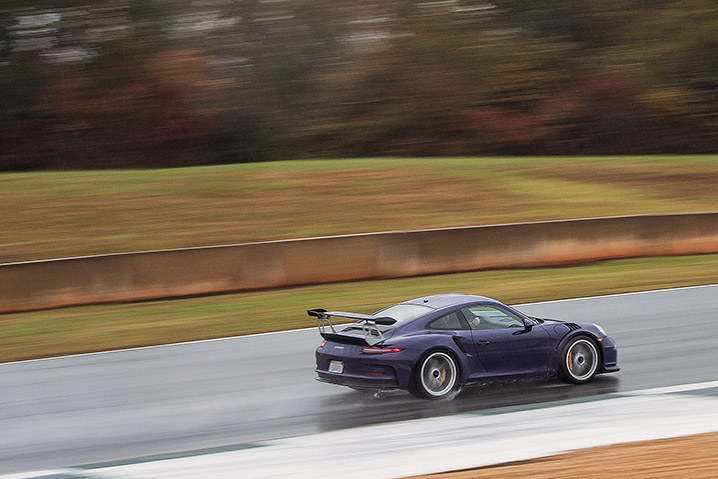
The brilliance of the RS is that we never noticed a situation where we were caught out on track and the car had to intervene to bring things back to square. If that happened, it was tidied up imperceptibly. Whether or not the computers were lending a hand, the RS makes a better partner in the wet than the GT4. It's fun, too. Very fun. The GT4 made us want to back off after every disconcerting wiggle, and the RS made us want to push harder. It's addictive. It's also surreal.This is an object of lust that imparts a feeling of incredible prowess in terrible conditions.
As we pull into the pits for the last time, we come back to the question of whether the RS is worth the $50,000 premium it commands over the GT3. We don't have an apples-to-apples comparison to draw upon; our last stint in the GT3 was in the dry on a rollercoaster of a southern Ohio road. Practical considerations, like the Boxster you could buy for the price difference between two cars separated by only 25 horsepower, aren't really the metrics to use. What potential customer would? This is an object of lust that imparts a feeling of incredible prowess in terrible conditions. It invites you to take risks under difficult conditions – unfamiliar, cold, wet racetracks, for example – and rewards rather than lashes out in return.
It's raining much harder now, and the GT4s are parked. They're too squirrelly, and Haywood doesn't want anyone to loop. As the rain patters on the magnesium roof, our ride to the plane home waiting, we want another go at Road Atlanta – rain be damned.










Sign in to post
Please sign in to leave a comment.
Continue